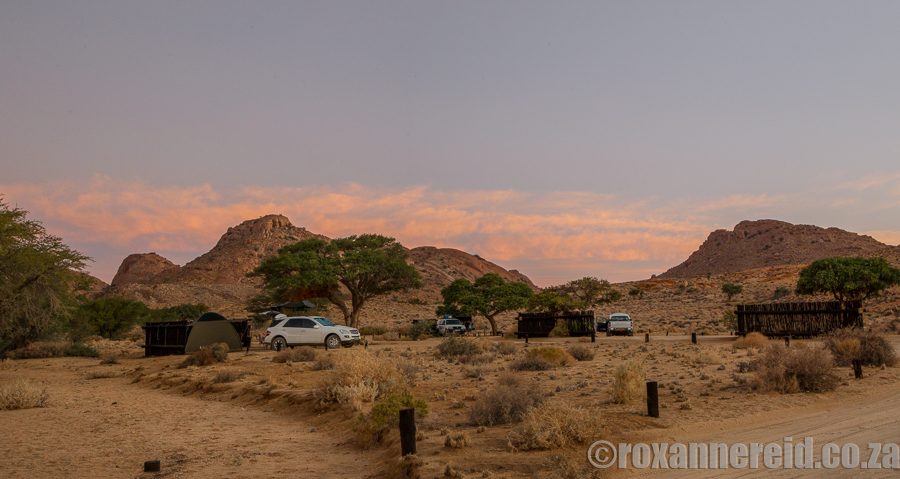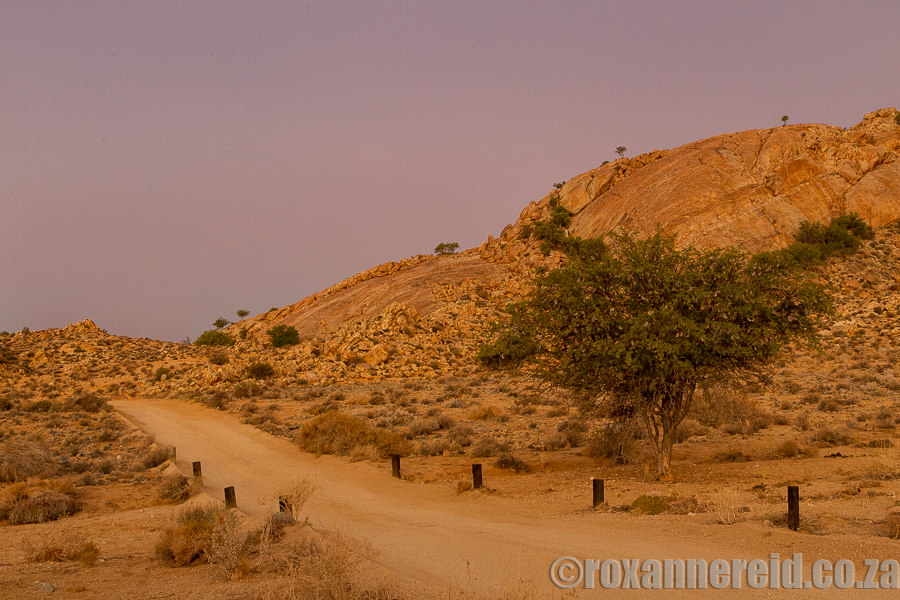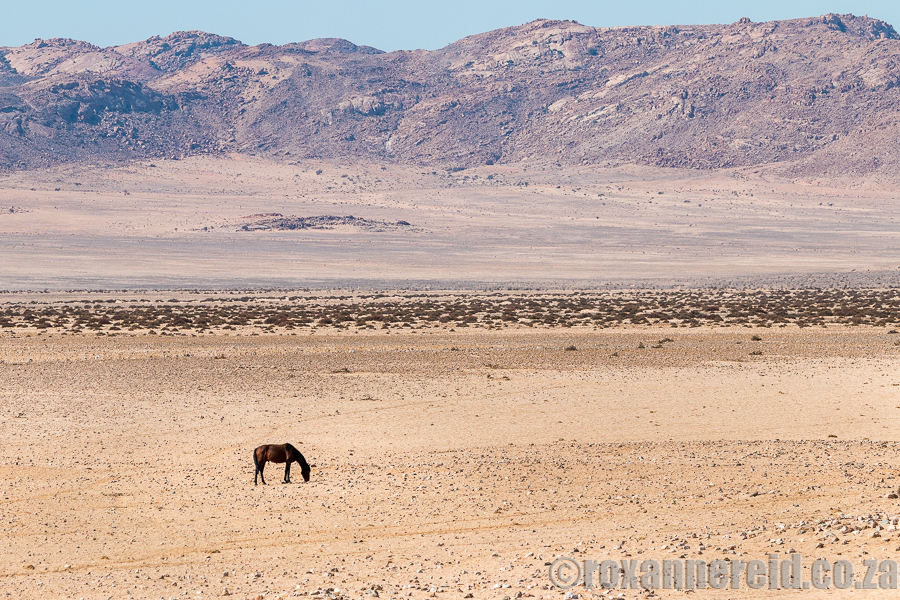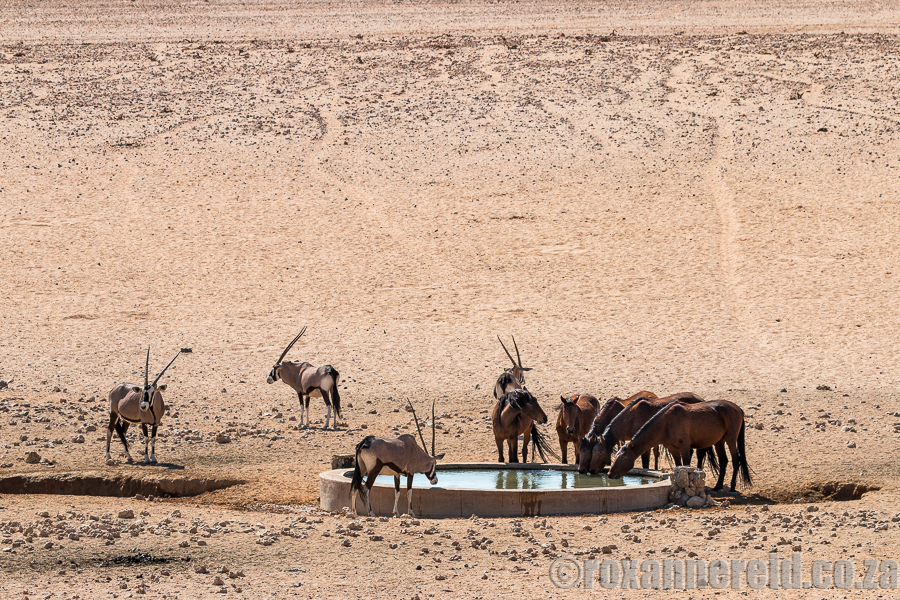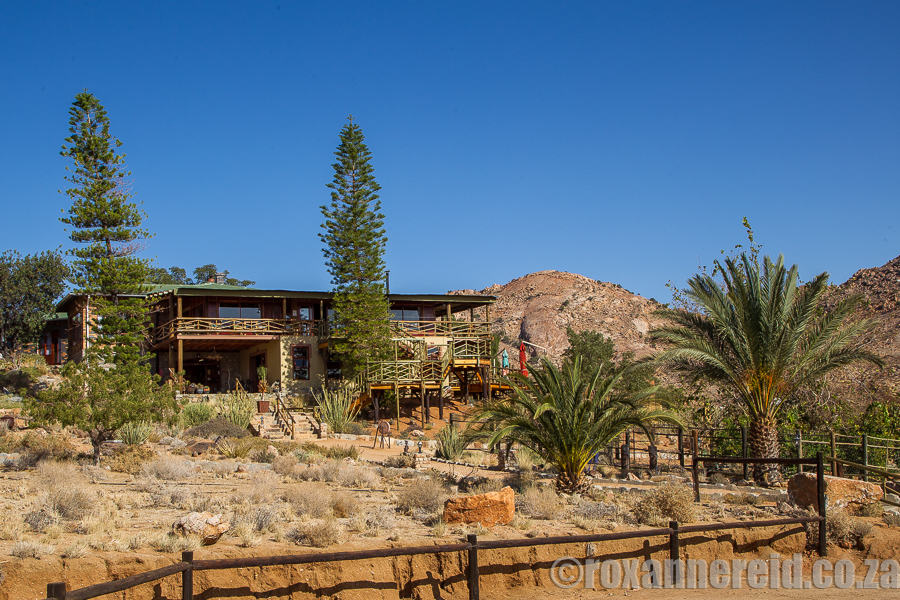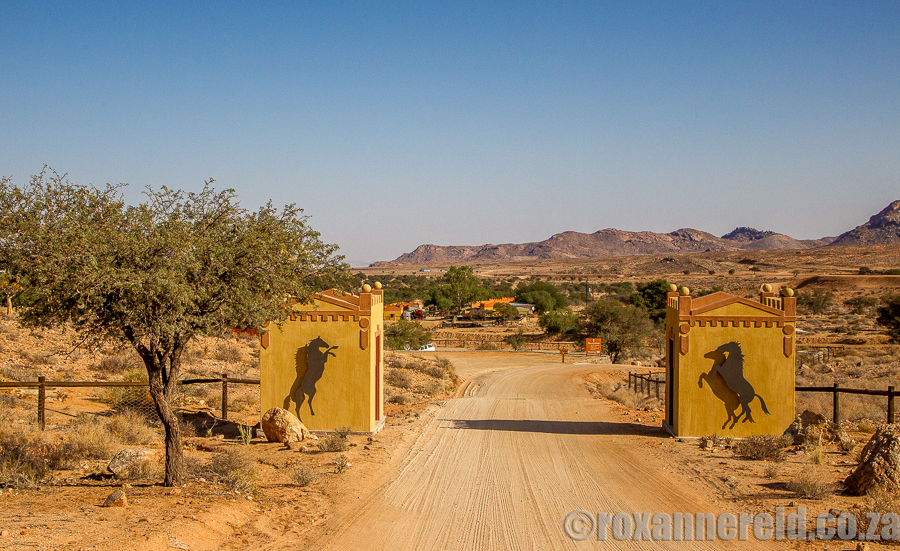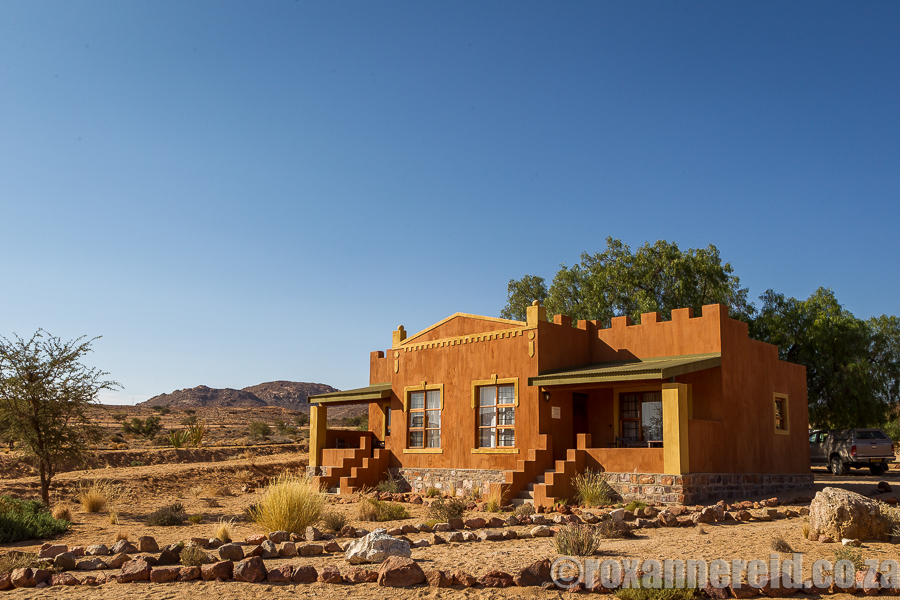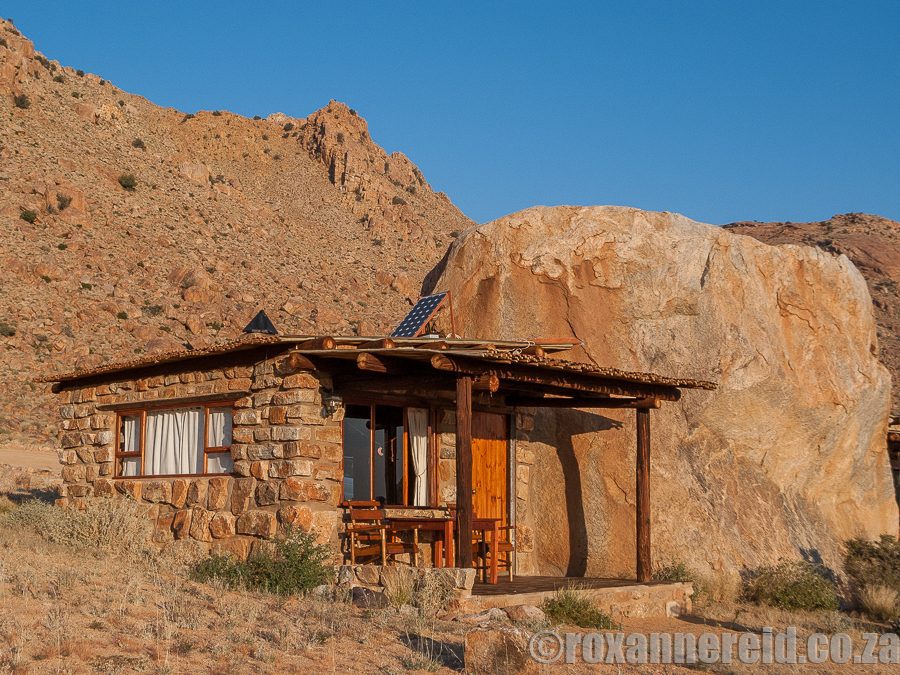
By Roxanne Reid
The landscape around the little town of Aus in southern Namibia was hot, parched and dusty. Klein Aus Vista’s Desert Horse Campsite, on the fringe of the Namib Desert and the Gondwana Sperrgebiet Rand Park, was our stopover for a couple of nights. We were there to see Namibia’s wild horses, but what we found at sunset were rocky koppies washed in ginger light.
The landscape around the little town of Aus in southern Namibia was hot, parched and dusty. Klein Aus Vista’s Desert Horse Campsite, on the fringe of the Namib Desert and the Gondwana Sperrgebiet Rand Park, was our stopover for a couple of nights. We were there to see Namibia’s wild horses, but what we found at sunset were rocky koppies washed in ginger light.
We set up camp under a camel thorn tree at Klein Aus Vista’s Desert Horse Campsite. This is how camping should be: no power points, but sites spaced far apart for privacy, running water, good ablutions and a kick-ass view of koppies of warm apricot boulders. Barking geckos clicked from their burrows as the setting sun transformed the rocks into a blaze of radiance. The sky to the west remained a deep blood red until long after the sun had slipped below the horizon.
The wild horses
The next morning we woke at dawn to the chirping of sociable weavers and enjoyed a lazy late breakfast. We’d been told that the best time to find wild horses at the Garub waterhole was between about 11:00 and 16:00 and we were only 20km away so there was no hurry.
The next morning we woke at dawn to the chirping of sociable weavers and enjoyed a lazy late breakfast. We’d been told that the best time to find wild horses at the Garub waterhole was between about 11:00 and 16:00 and we were only 20km away so there was no hurry.
It’s luck of the draw whether you get to see the horses at Garub, especially in the dry season when they need to travel long distances for grazing. But when we arrived, our tyres crunching over the stones and dry earth, three horses were already drinking with about a dozen gemsbok. We watched from the hide overlooking the waterhole, the silence so deep it was as if our ears were blocked, the heat oppressive even in the shade of the hide.
Then a guide from Desert Horse Inn (also part of Klein Aus Vista) arrived with a small clutch of foreigners. He told us that the horses eat their own dung, a desert adaptation that ups their protein intake (it’s twice as rich in protein as the dry grass) and makes sure they get the most from the nutrients in their grass diet. In dry times like this, they’ll spend some 20 hours a day grazing, but when the grazing is better after good rains it drops to about 12 hours.
Then a guide from Desert Horse Inn (also part of Klein Aus Vista) arrived with a small clutch of foreigners. He told us that the horses eat their own dung, a desert adaptation that ups their protein intake (it’s twice as rich in protein as the dry grass) and makes sure they get the most from the nutrients in their grass diet. In dry times like this, they’ll spend some 20 hours a day grazing, but when the grazing is better after good rains it drops to about 12 hours.
He said there were now about 200 horses, up from 165 when we last visited in 2008. The size of the herd fluctuates, depending on the rainfall to provide grazing. They’re divided up into 25 families, and the stallions outnumber the mares 136 to 64.
As we were chatting another herd of ten horses appeared far away on the horizon, trailing in a straggling line, kicking up puffs of dust. The nearer they got to the water the more excited they seemed to get; they picked up their pace and there was some head shaking and a small back-kick from one of them before they bent their heads to drink.
As we were chatting another herd of ten horses appeared far away on the horizon, trailing in a straggling line, kicking up puffs of dust. The nearer they got to the water the more excited they seemed to get; they picked up their pace and there was some head shaking and a small back-kick from one of them before they bent their heads to drink.
I know the life of a wild horse in the Namib is a hard one, with punishing heat, long distances to cover in search of food and water, and high mortality rates during times of drought. But it was a thrill to see them drinking alongside gemsbok, just another wild animal. Not a paddock or fence in sight, no need to jump over manmade obstacles or have their beautiful manes tamed into tight plaits or knots. A harsh life, certainly, but they’re free to roam where they choose, to form their own social structures – and it’s beautiful.
Aus info centre
After lunch on the deck at Desert Horse Inn we visited the small info centre at Aus, where you can buy a cold drink or have a light meal. But we were there for the poster displays telling the history of the area and its horses.
There are various romantic theories of how these horses came to be here, but the herd probably descended from horses that belonged to the South African army, German colonial forces and the Kreplin stud that bred horses to work in the diamond mines. Left behind in the turmoil of World War I, they were never recaptured thanks to restricted entry to the diamond fields at the coast.
From the displays we learnt that the area is a hotspot for plants, with some 500 species in a radius of 50km, and how fog moves in from the coast to sustain them. If you see the area when it’s as parched as it was when we visited at the beginning of winter, your mouth will drop open in wonder at the poster about the desert in bloom. Think Namaqualand and you’ll get an idea of what this beige-brown desert can look like from July to September, when the plains may burst into yellow, pink, purple and blue flowers.
After lunch on the deck at Desert Horse Inn we visited the small info centre at Aus, where you can buy a cold drink or have a light meal. But we were there for the poster displays telling the history of the area and its horses.
There are various romantic theories of how these horses came to be here, but the herd probably descended from horses that belonged to the South African army, German colonial forces and the Kreplin stud that bred horses to work in the diamond mines. Left behind in the turmoil of World War I, they were never recaptured thanks to restricted entry to the diamond fields at the coast.
From the displays we learnt that the area is a hotspot for plants, with some 500 species in a radius of 50km, and how fog moves in from the coast to sustain them. If you see the area when it’s as parched as it was when we visited at the beginning of winter, your mouth will drop open in wonder at the poster about the desert in bloom. Think Namaqualand and you’ll get an idea of what this beige-brown desert can look like from July to September, when the plains may burst into yellow, pink, purple and blue flowers.
By now we were eager to get back to our campsite to cool off with a shower. Then we poured a glass of wine and sat back in our camping chairs to enjoy the late afternoon light show and wait for the stars to come out to play. This is the best part of the day, a magic hour or two for anyone who enjoys simple camping, wide open spaces, striking sunsets and starry skies.
Need to know
1. Klein Aus Vista (part of the Gondwana Collection) is a great stopover on your way to the coastal town of Lüderitz and the diamond ghost town of Kolmanskop, throwing in a chance to see the wild horses of the Namib.
Need to know
1. Klein Aus Vista (part of the Gondwana Collection) is a great stopover on your way to the coastal town of Lüderitz and the diamond ghost town of Kolmanskop, throwing in a chance to see the wild horses of the Namib.
2. If you don’t want to camp, stay in a chalet at the Desert Horse Inn.
3. To spoil yourself, book at the self-catering Eagle’s Nest. We stayed here a few years ago and loved our chalet built into a rock so that a massive boulder formed the wall of the living area. In keeping with the natural theme, the floor was stone and the lintels made of old railways sleepers. But best of all were the sprawling views out over plains fringed with far mountains and the deep sense of serenity.
4. If your legs are itching for some exercise and an excuse to wander through the landscape, ask at Desert Horse Inn reception about the hiking trails in the area.
5. You’ll find the Aus info centre at the turnoff into the little settlement of Aus from the B4, which continues on to Lüderitz.
Copyright © Roxanne Reid - No words or photographs on this site may be used without permission from roxannereid.co.za
You may also enjoy:
Camping in the Namtib Biosphere Reserve, Namibia
NamibRand Nature Reserve: put it on your life list
More about Namibia
5. You’ll find the Aus info centre at the turnoff into the little settlement of Aus from the B4, which continues on to Lüderitz.
Copyright © Roxanne Reid - No words or photographs on this site may be used without permission from roxannereid.co.za
You may also enjoy:
Camping in the Namtib Biosphere Reserve, Namibia
NamibRand Nature Reserve: put it on your life list
More about Namibia
